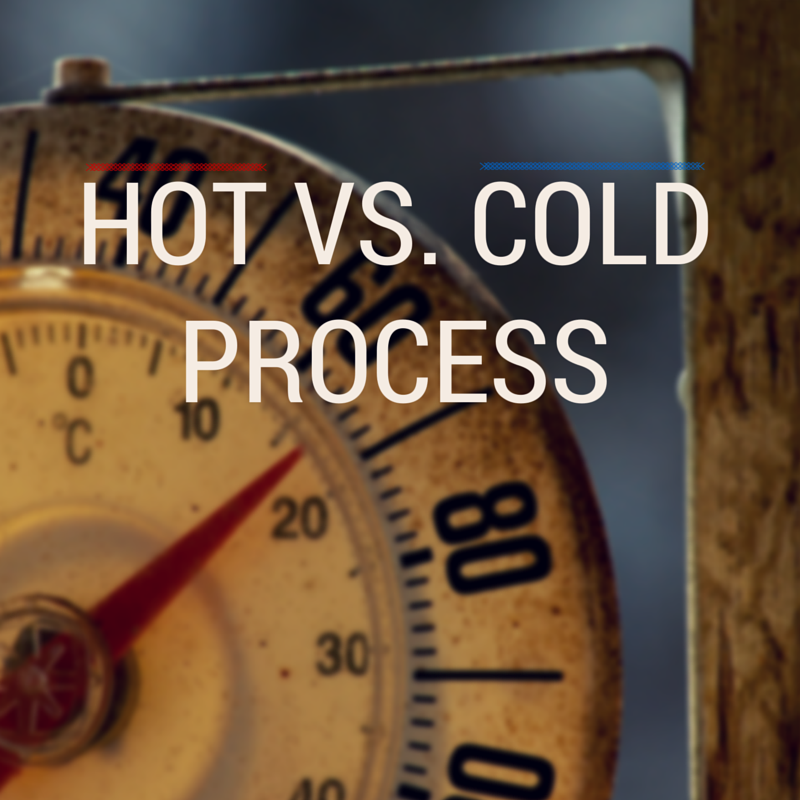Hello, shavers & soapers! In this post we’re going to discuss the two predominant methods of small-scale soap making: cold process and hot process. As you’d guess, the difference between the two is the temperature the fat and lye react at.
We’re going to cover the differences between hot process and cold process, the benefits of each, and which one is better for shaving soap, as well as a bit about stearic acid.
Back in Soap Making: A Beginner’s 10-Step Guide, we went over the basics of making regular old soap. The process we covered there is cold process.
Cold process involves equalizing the temperature of your lye solution and your fats, mixing them, and pouring the soap out once it’s reached trace. The soap generates its own heat while it undergoes saponification. This is the most common method for making standard soap.
However, shaving soap is a little different. The important qualities in shaving soap are different to the important qualities of regular soap. Thus, it requires different ingredients in different proportions.
Because shaving soap is a different product that uses different ingredients, cold process isn’t always ideal.
Stearic Acid
For example, stearic acid is a predominant ingredient in a lot of shaving soap. Stearic acid is a fatty acid, as opposed to a triglyceride, which is broken down by lye into glycerol and a fatty acid. Breaking a triglyceride down takes the lye a little time.
But because stearic acid is broken down already, it’s available for the lye to react with right away – so pouring lye into a tub of mostly stearic acid will produce almost instant saponification.
As you can imagine, that is disconcerting at best, and at worst will cause you to abandon your batch of soap.
When a cold process soap reaches trace too quickly, sometimes it goes too far before you can do anything about it, and becomes a pot of rapidly solidifying soap. This is known as seizing or soap-on-a-stick among soapers. Seizing can also be caused by reactions with fragrance oils, high temperature, and other factors.
However, in hot process soap, the soap is kept warmer for longer. This allows you to stop it from solidifying, in spite of the ongoing saponification. At the end of the hot process method, the soap should have a consistency similar to Vaseline. (To see an example of the stages of hot process soap, check out this soaping101 video)
Of course, in the case of large proportions of stearic acid, that’s a moot point. Stearic acid only melts at 157°F – quite a bit higher than the temperatures used in cold process. This is fine when you’re using stearic acid as only a few percent of your fats and you can blend it in, as in most regular soap – but in shaving soap, stearic acid is sometimes as much as 50% of the fat in the recipe.
What is the Hot Process Method?
The idea of the hot process method is to force saponification to take place sooner. If you recall the post on cold process, after the soap reaches trace, it’s left in a mold, sliced, and cured. Saponification and water evaporation are ongoing throughout these later stages.
In hot process, you continue to heat the soap for 1-2 hours (usually in a crock pot). This heat helps the saponification process along. It also helps water to evaporate. The heat it’s held at will vary according to the equipment you’re using. Typically, the warm or low settings on a crock pot are fine.
The soap is done cooking when it passes your pH test. I recommend using litmus paper or a similar pH indicator. Many soapers use the tongue test: put a bit of the soap aside to cool, and touch it to your tongue. If you feel a zap (a chemical burn from the lye), it’s not done. If you taste soap, it’s good to go. (Hey, if you’re anything like me, you had it coming with that filthy mouth of yours.)
Once it’s reached the Vaseline-like gel stage and passes a pH test, you’re ready to add any fragrances, superfats, etc. Then you can spoon the soap into whatever mold you’re using.
Why Use Hot Process over Cold Process?
There are a bunch of reasons hot process is generally better than cold process for making shaving soap:
- No seizing. Hot process tends to be more forgiving when it comes to fragrances, temperature, high stearic acid content, etc.
- There’s no lye to react with things you add toward the end, such as fragrances or colours.
- Because saponification happens in the pot, your soap is ready to go once it’s cooled and solidified.
That’s right. With cold process, you might wait more than a month to test your soap. Not so with hot process. For me, that alone makes hot process shaving soap preferable.
So Why Does Anyone Use Cold Process?
In spite of the reasons above, a lot of soap makers prefer cold process. Why is that?
- Aesthetic reasons such as the colour and texture of the finished soap. Hot process soap doesn’t have the smooth, pastel look of cold process soap.
- It’s easier to work with (not only does hot process soap look like Vaseline, it pours like it too!)
- Because it’s less viscous, you can do fancy things like swirls.
- It’s less active time preparing the soap at the expense of waiting longer to use it.
You’ll probably notice that none of those matter very much when you’re making shaving soap.
Cold process and hot process both have their place in making regular soap. In shaving soap, it’s a bit easier to use hot process, but feel free to experiment with cold process.
Important Tips for Hot Process Shaving Soap
- Don’t fill your crock pot past about 25%. Towards the middle of the process, the soap will begin to rise. Don’t leave your soap unattended for long. Just give it a good stir to knock the air out of it.
- In fact, stirring your soap any time it starts to rise, separate, or get any other irregular consistency is a good idea.
- Be careful when handling hot soap. Not only is it hot, it will become thick and sticky. In the time between the soap landing on you and your brain figuring out what you should do about it, you could get burned. The minimum temperature that can cause burns is 140°F, and your soap will be past that.
- Once the soap starts to thicken, it will be easier to stir with a spoon or spatula than an immersion blender. Come on, work that upper body!
- Remember – test in small batches. When making hot process shaving soap, you might have to find a small vessel to act as a double boiler in a crock pot.
——————————
That’s all for now, guys and girls. I hope this post helped you understand a little more about the soap making process in regards to shaving soap. You should understand more about why you would use cold process or hot process and what to expect out of each method. Plus, the stearic acid section should give you an idea of the direction I’ll be going with some future posts!
Do you have any questions about hot or cold process? Need more information on another topic? Let me know in the comments!
Until next time,
Lewis

